





RWY004.jpg
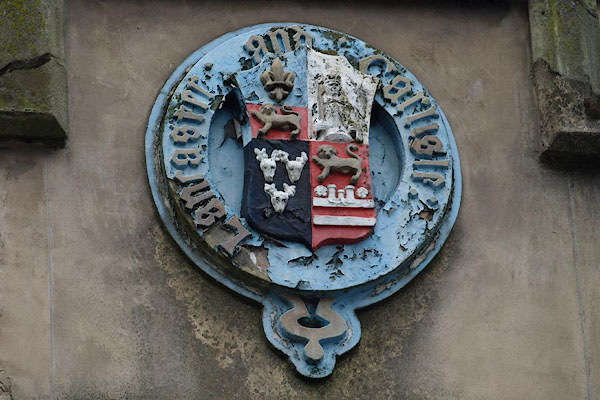
BRP91.jpg Coat of arms on Carlisle Citadel Station.
(taken 29.9.2009)
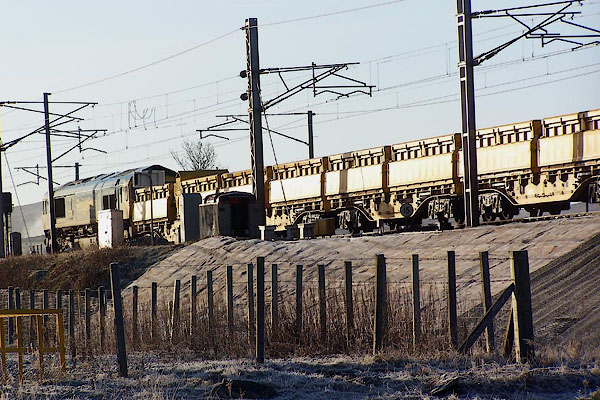
BLN12.jpg Goods train S of Shap.
(taken 4.1.2006)
placename:- Lancaster and Carlisle Railway
OS County Series (Wmd 14 2)
item:- stone circle
 goto source
goto sourceGentleman's Magazine 1844 part 2 p.381 "Druidical Temple near Shap."
"... NOTWITHSTANDING the alleged increase in good taste at the present day, I find it is the intention of the projectors of the Lancaster and Carlisle Railway to carry their line through, and destroy, a most interesting remnant of antiquity, the remains of a Druidical Temple situated in a field the property of the earl of Lonsdale, on the road from Kendal to Shap, ... I am surprised that the noble Earl should permit such barbarity, with such influence as he possesses over the Company. ..."
"Yours, &c."
"DRUID."
 goto source
goto sourceGentleman's Magazine 1846 part 2 p.526 "Sept. 28. The first portion of the Lancaster and Carlisle Railway, to Kendal (Commenced in the latter part of September, 1843), was opened on Monday. It extends twenty-two miles. On arriving at Kendal, the directors, with their officers, and a large party of friends, repaired, by special invitation from the directors of the Kendal and Windermere railway, to the White Hall, where a handsome dejeuner awaited their arrival. Cornelius Nicholson, esq. mayor of Kendal, presided."
placename:- Lancaster and Carlisle Railway
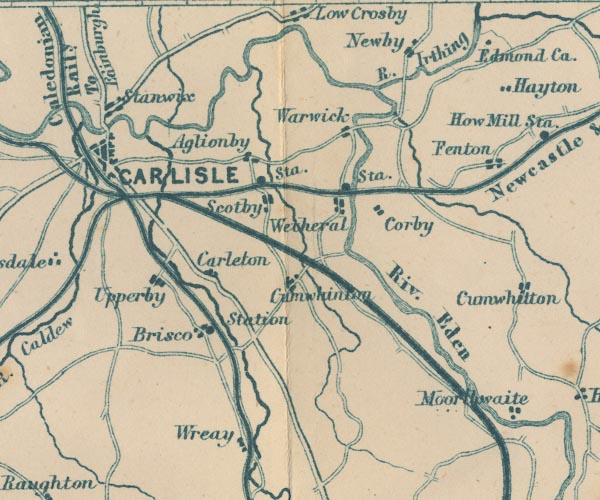
GAR2NY45.jpg
triple line, light bold light, railway
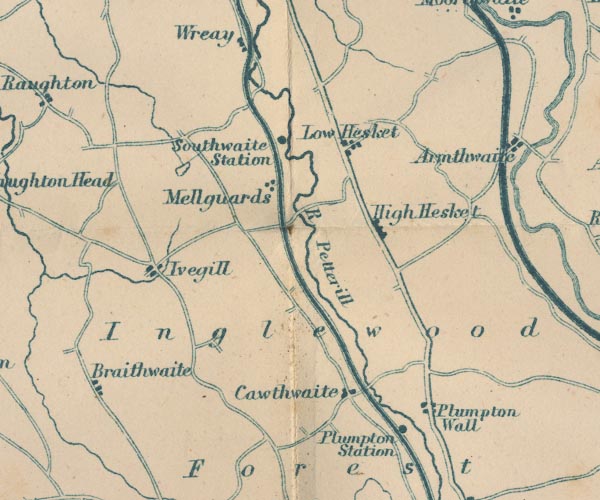
GAR2NY44.jpg
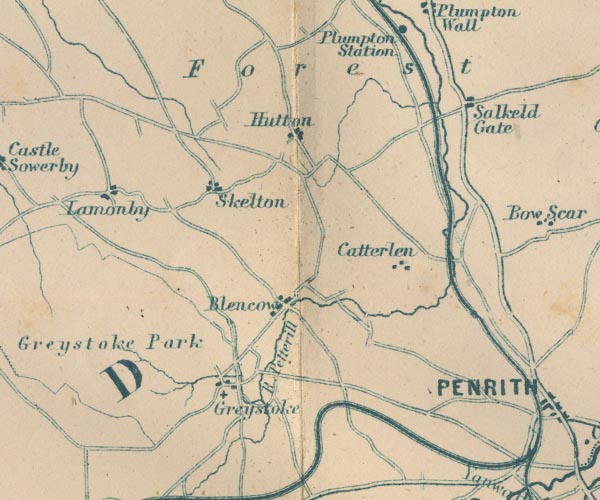
GAR2NY43.jpg
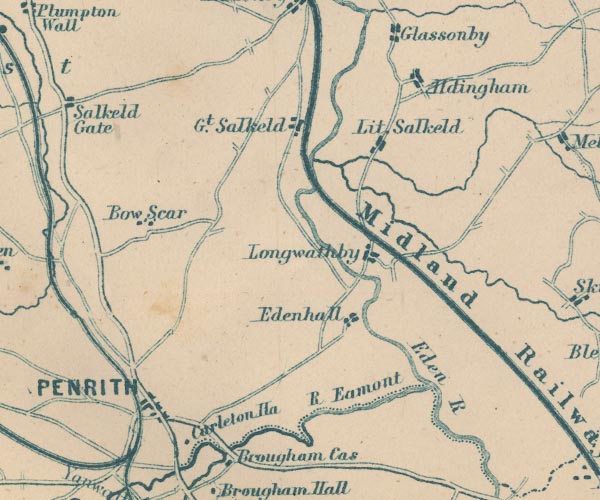
GAR2NY53.jpg
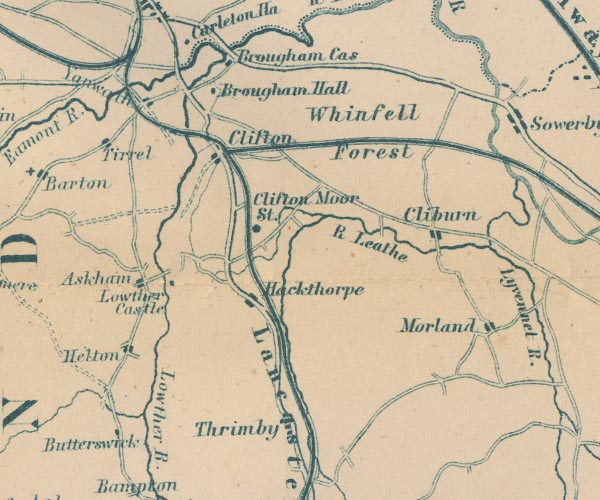
GAR2NY52.jpg
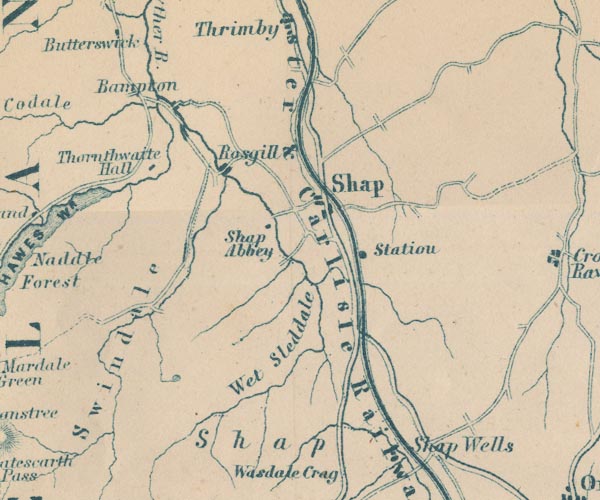
GAR2NY51.jpg
"Lancaster &Carlisle Railway"
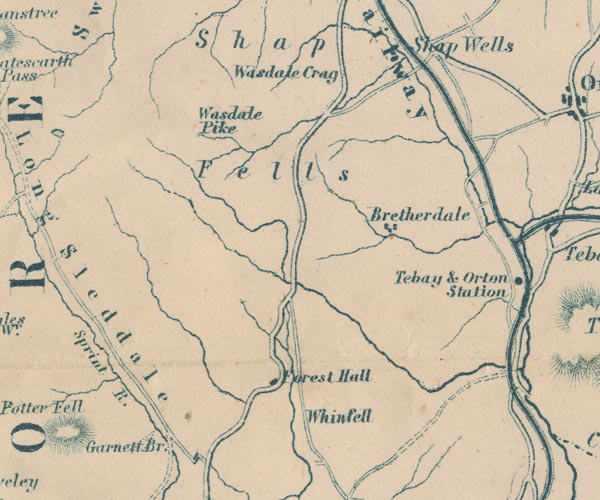
GAR2NY50.jpg

GAR2NY60.jpg

GAR2SD69.jpg
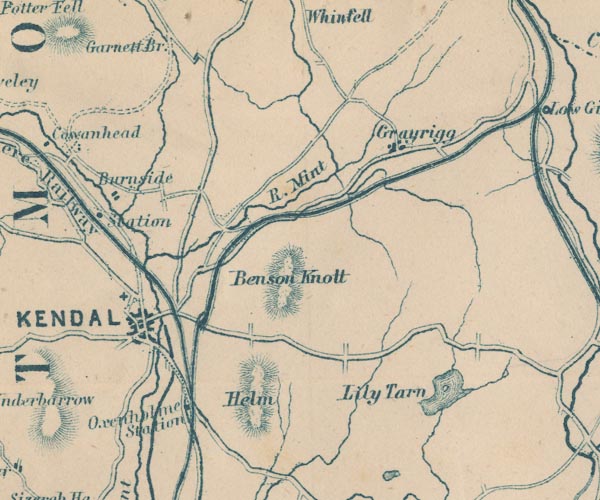
GAR2SD59.jpg
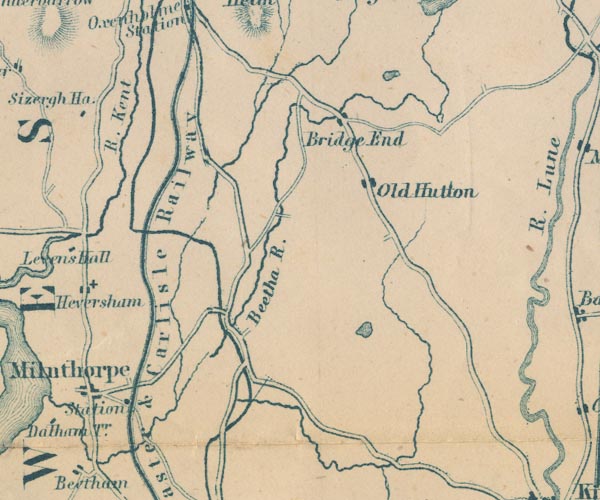
GAR2SD58.jpg
"Lancaster &Carlisle Railway"

GAR2SD57.jpg
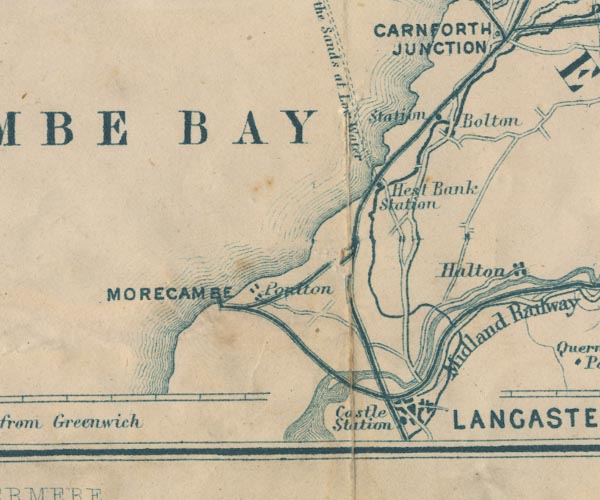
GAR2SD46.jpg
item:- JandMN : 82.1
Image © see bottom of page
 goto source
goto sourcePage 3:- "The traveller arrives [at Windermere], we must suppose, by the railway from Kendal, having been dropped at the Oxenholme Junction by the London train from the south, or the Edinburgh and Carlisle train from the north."
 goto source
goto sourcePage 4:- "The railways skirt the lake district, but do not, and cannot, penetrate it: for the obvious reason that railways cannot traverse or pierce granite mountains or span broad lakes. If the time should ever come when iron roads will intersect the mountainous parts of Westmorland and Cumberland, that time is not yet; nor is in view,- loud as have been the lamentations of some residents, as if it were to happen to-morrow. No one who has ascended Dunmail Raise, or visited the head of Coniston Lake, or gone by Kirkstone to Patterdale, will for a moment imagine that any conceivable railway will carry strangers over those passes, for generations to come. It is a great thing that steam can convey travellers round the outskirts of the district, and up to its openings. This is now effectually done; and it is all that will be done by the steam locomotive during the lifetime of anybody yet born. The most important of the openings thus reached is that of WINDERMERE."
"The mountain region of Cumberland and Westmorland has for its nucleus the cluster of tall mountains, of which Scawfell is the highest. There are the loftiest peaks and deepest valleys. These are surrounded by somewhat lower ridges and shallower vales; and these again by others, till the uplands are mere hills. and the valleys scarcely sunk at all. It is into these exterior undulations that the railways penetrate; and, at the first ridge of any steepness, they must stop. It is this which decides the termination of the Windermere railroad, and which prevents the lateral railways from coming nearer than the outer base ..."
item:- Bradshaw's Railway Guide
 goto source
goto sourcePage 5:- "... ..."
"These two [Thomas Idle and Francis Goodchild] had sent their personal baggage on by train: only retaining each a knapsack. Idle now applied himself to constantly regretting the train, to tracking it through the intricacies of Bradshaw's Guide, and finding out where it is now - and where now - and where now - and to asking what was the use of walking, when you could ride at such a pace as that. Was it to see the country? If that was the object, then look at it out of the carriage windows. There was a great deal more of it to be seen there than here. Besides, who wanted to see the country? Nobody. And again, whoever did walk? Nobody. Fellows set off to walk, but they never did it. They came back and said they did, but they didn't. Then why should he walk? He wouldn't walk. He swore it by this milestone!"
"It was the fifth from London, so far had they penetrated into the North. Submitting to the powerful chain of argument, Goodchild proposed a return to the Metropolis, and a falling back on Euston Square Terminus. Thomas assented with alacrity, and so they walked down into the North by the next morning's express, and carried their knapsacks in the luggage-van."
"It was like all other expresses, as every express is and must be. It bore through the harvest country a smell like a large washing-day, and a sharp issue of steam as from a huge brazen tea-urn. The greatest power in nature and art combined, it yet glided over dangerous heights in the sight of people looking up from fields and roads, as smoothly and unreally as a light miniature plaything. Now the engine shrieked in hysterics of such intensity, that it seemed desirable that the men who had"
 goto source
goto sourcePage 6:- "her in charge should hold her feet, slap her hands, and bring her to; now, burrowed into tunnels with a stubborn and undemonstrative energy so confusing that the train seemed to be flying back into leagues of darkness. Here, were station after station, swallowed up by the express without stopping; here, stations where it fired itself in like a volley of cannon-balls, swooped away four country-people with nosegays, and three men of business with portmanteaus, and fired itself off again, bang, bang, bang! At long intervals were uncomfortable refreshment-rooms, made more uncomfortable by the scorn of Beauty towards Beast, the public (but to whom she never relented, as Beauty did in the story, towards the other Beast), and where sensitive stomachs were fed, with a contemptuous sharpness occasioning indigestion. Here, again, were stations with nothing going but a bell, and wonderful wooden razors set aloft on great posts, shaving the air. In these fields, the horses, sheep, and cattle were well used to the thundering meteor, and didn't mind; in those, they were all set scampering together, and a herd of pigs scoured after them. The pastoral country darkened, became coaly, became smoky, became infernal, got better, got worse, improved again, grew rugged, turned romantic; was a wood, a stream, a chain of hills, a gorge, a moor, a cathedral town, a fortified place, a waste. Now, miserable black dwellings, a black canal, and sick black towers of chimneys; now, a trim garden, where the flowers were bright and fair; now, a wilderness of hideous altars all a-blaze; now, the water meadows with their fairy rings; now, the mangy patch of unlet building ground outside the stagnant town, with the larger ring where the Circus was last week. The temperature changed, the dialect changed, the people changed, faces got shaper, manner got short, eyes got shrewder and harder; yet all so quickly, that the spruce guard in the London uniform and silver lace, had not yet rumpled his shirt-collar, delivered half the dispatches in his shiny little pouch, or read his newspaper."
"Carlisle! Idle and Goodchild had got to Carlisle. ... ..."
placename:- London and North Western Railway
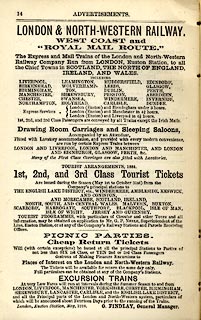 click to enlarge
click to enlargeJK1208.jpg
Adverts p.14 at the back of Jenkinson's Smaller Practical Guide to Carlisle, Gilsland, Roman Wall and Neighbourhood.
item:- Armitt Library : A1717.9
Image © see bottom of page
item:- mail coach; stage coach
HP01p146.txt
Page 146:- "..."
"... the irony of fate long ago overtook the canal, in its conversion into a railway."
"It was in December, 1846, that the first railway ran into Carlisle from the south. It was the Lancaster and Carlisle"
HP01p147.txt
Page 147:- "Railway, long since absorbed into the London and North-Western. In September, 1847, the Caledonian Railway, from Carlisle to Moffat, carried on the new methods another stage, and in the following February it was further extended to Glasgow and Edinburgh. It was necessarily the death-blow of the coaches along the main route. ..."
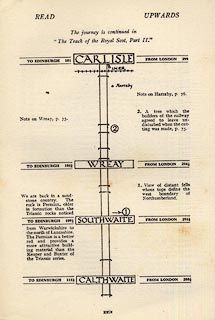 click to enlarge
click to enlargeLS3p29.jpg
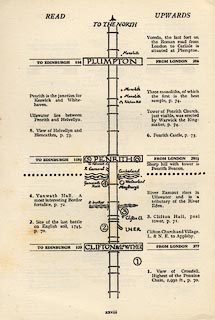 click to enlarge
click to enlargeLS3p28.jpg
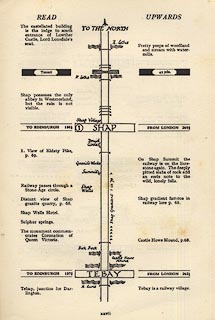 click to enlarge
click to enlargeLS3p27.jpg
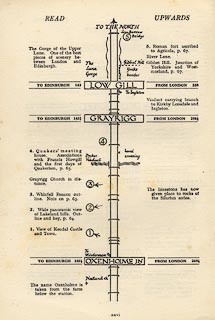 click to enlarge
click to enlargeLS3p26.jpg
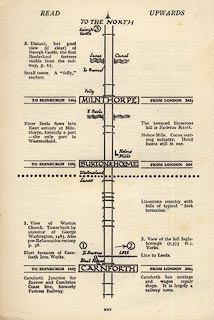 click to enlarge
click to enlargeLS3p25.jpg
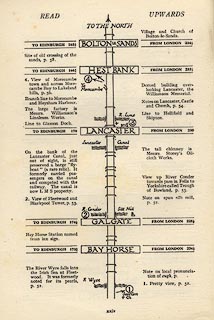 click to enlarge
click to enlargeLS3p24.jpg
item:- JandMN : 95.2
Image © see bottom of page
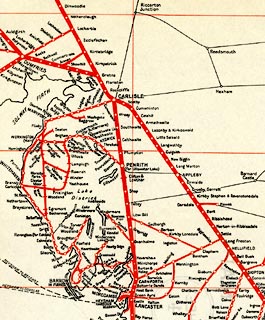 click to enlarge
click to enlargeLMS6Cm.jpg
"MAP OF LMS RAILWAY"
item:- JandMN : 1016.5
Image © see bottom of page
Awdry, Christopher: 1990: Encyclopaedia of British Railway Companies: Guild Publishing (London)
Joy, David: 1983 &1990: Regional History of the Railways of Great Britain; the Lake Counties (vol.14): David and Charles (Newton Abbot, Devon):: ISBN 0 946537 56 9
Nicholson, Cornerlius: 1837: London and Glasgow Railway; the Interests of Kendal Considered
 Travelling Post Office photos
Travelling Post Office photos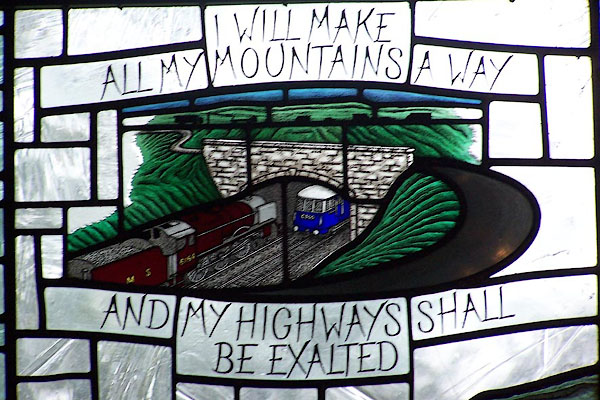
BJZ85.jpg Detail from the Millennium Window, St Michael's Church, Shap, design by Adam Goodyear, 2000.
(taken 11.11.2005)
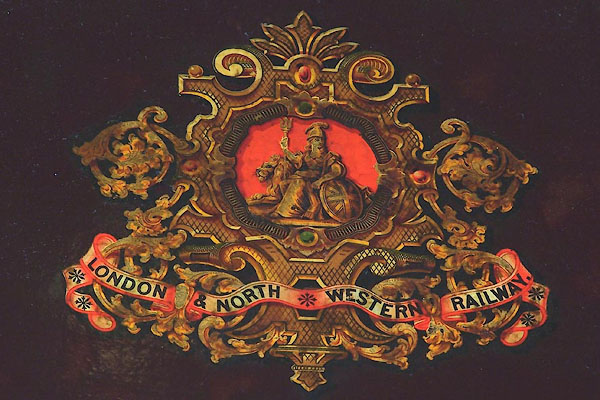
BLW38.jpg (taken 18.4.2006)
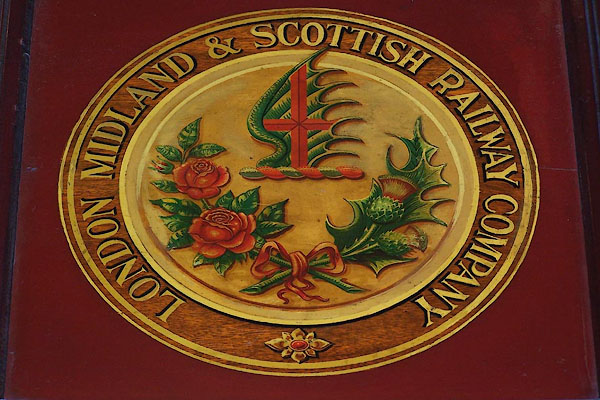
BLW36.jpg (taken 18.4.2006)
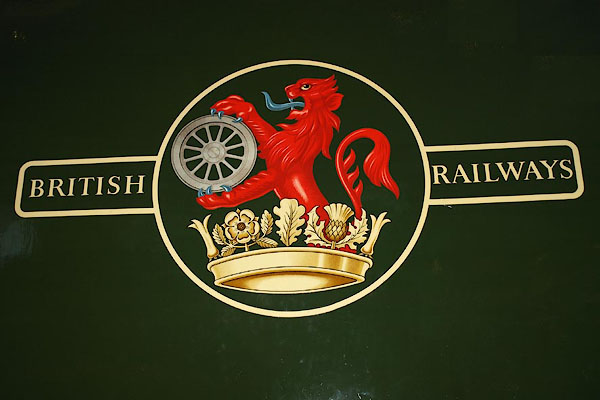
BPQ83.jpg (taken 2008)

BPR01.jpg LMS / United Dairies milk tank wagon, 1937.
(taken 2008) courtesy of the National Railway Museum.
: Lancaster and Carlisle Railway
to 1879
: London and North Western Railway; LNWR
to 1923
: London, Midland and Scottish Railway; LMS
to 1948
: British Railways; BR
 Kendal and Windermere Railway (opened 1855)
Kendal and Windermere Railway (opened 1855) Lancaster Station, Lancashire
Lancaster Station, Lancashire railway bridge, Burton-in-Kendal
railway bridge, Burton-in-Kendal Burton and Holme Station, Burton-in-Kendal
Burton and Holme Station, Burton-in-Kendal[railway bridge, Holme (2)]
 railway bridge, Holme
railway bridge, Holme railway bridge, Beetham (2)
railway bridge, Beetham (2) railway milepost, Beetham
railway milepost, Beetham railway bridge, Beetham
railway bridge, Beetham[railway bridge, Beetham (3)]
 Milnthorpe Station, Milnthorpe
Milnthorpe Station, Milnthorpe railway bridge, Milnthorpe
railway bridge, Milnthorpe Rowell Railway Bridge, Heversham
Rowell Railway Bridge, Heversham Woodhouse Bridge, Woodhouse
Woodhouse Bridge, Woodhouse railway bridge, Hincaster (2)
railway bridge, Hincaster (2) railway milepost, Hincaster
railway milepost, Hincaster Hincaster Junction, Hincaster
Hincaster Junction, Hincaster railway bridge, Hincaster (3)
railway bridge, Hincaster (3) Railway Cottages, Hincaster
Railway Cottages, Hincaster[railway bridge, Hincaster (5)]
 railway bridge, Hincaster (4)
railway bridge, Hincaster (4) railway bridge, Sedgwick
railway bridge, Sedgwick Newland Bridge, Natland
Newland Bridge, Natland railway bridge, Natland
railway bridge, Natland railway bridge, Oxenholme (2)
railway bridge, Oxenholme (2) engine shed, Oxenholme (4)
engine shed, Oxenholme (4) Kendal Junction, Oxenholme
Kendal Junction, Oxenholme railway bridge, Oxenholme
railway bridge, Oxenholme Oxenholme Station, Oxenholme
Oxenholme Station, Oxenholme railway bridge, Kendal (3)
railway bridge, Kendal (3) railway bridge, Kendal (7)
railway bridge, Kendal (7) railway bridge, Kendal (16)
railway bridge, Kendal (16) railway bridge, Kendal (2)
railway bridge, Kendal (2)[railway bridge, Kendal (5)]
[railway bridge, Scalthwaiterigg (2)]
[railway bridge, Scalthwaiterigg (3)]
 railway bridge, Scalthwaiterigg
railway bridge, Scalthwaiterigg Hayfell Bridge, Scalthwaiterigg
Hayfell Bridge, Scalthwaiterigg Appleby Road Bridge, Docker
Appleby Road Bridge, Docker railway milepost, Docker
railway milepost, Docker railway bridge, Docker
railway bridge, Docker Docker Viaduct, Docker
Docker Viaduct, Docker Lambrigg Crossing, Lambrigg
Lambrigg Crossing, Lambrigg Grayrigg Station, Lambrigg (2)
Grayrigg Station, Lambrigg (2) Beck House Bridge, Lambrigg
Beck House Bridge, Lambrigg Grayrigg Station, Lambrigg
Grayrigg Station, Lambrigg railway milepost, Lambrigg
railway milepost, Lambrigg railway crossing, Lambrigg
railway crossing, Lambrigg Morsedale Hall Bridge, Lambrigg
Morsedale Hall Bridge, Lambrigg railway bridge, Lambrigg (2)
railway bridge, Lambrigg (2) railway bridge, Lambrigg
railway bridge, Lambrigg railway bridge, Firbank (3)
railway bridge, Firbank (3) railway bridge, Firbank (2)
railway bridge, Firbank (2) railway bridge, Lowgill
railway bridge, Lowgill Lowgill Station, Lowgill (2)
Lowgill Station, Lowgill (2) Lowgill Station, Lowgill
Lowgill Station, Lowgill Lowgill Junction, Lowgill
Lowgill Junction, Lowgill Hest Bank Station, Lancashire
Hest Bank Station, Lancashire Borrowbridge Viaduct, Low Borrowbridge
Borrowbridge Viaduct, Low Borrowbridge Dillicar Water Troughs, Tebay
Dillicar Water Troughs, Tebay railway bridge, Tebay
railway bridge, Tebay[memorial, Tebay]
 railway bridge, Tebay (2)
railway bridge, Tebay (2) engine shed, Tebay (2)
engine shed, Tebay (2) Tebay South Junction, Tebay
Tebay South Junction, Tebay Tebay Station, Tebay
Tebay Station, Tebay Tebay Station Junction, Tebay
Tebay Station Junction, Tebay Tebay North Junction, Tebay
Tebay North Junction, Tebay railway bridge, Tebay (3)
railway bridge, Tebay (3) railway bridge, Tebay (4)
railway bridge, Tebay (4) catenary, Tebay
catenary, Tebay Loups Fell Bridge, Tebay
Loups Fell Bridge, Tebay engine shed, Tebay
engine shed, Tebay Birkbeck Viaduct, Tebay
Birkbeck Viaduct, Tebay Scotchman's Bridge, Orton S
Scotchman's Bridge, Orton S railway bridge, Orton S
railway bridge, Orton S[railway bridge, Orton S (2)]
[railway crossing, Orton S]
 railway bridge, Shap Wells
railway bridge, Shap Wells[railway footbridge, Shap Rural]
 Railway Cottages, Shap Rural
Railway Cottages, Shap Rural Shap Summit, Shap Rural
Shap Summit, Shap Rural railway bridge, Shap Rural
railway bridge, Shap Rural railway sidings, Hardendale Quarry
railway sidings, Hardendale Quarry railway culvert, Shap
railway culvert, Shap railway bridge, Shap (4)
railway bridge, Shap (4) railway bridge, Shap (5)
railway bridge, Shap (5) railway bridge, Shap (3)
railway bridge, Shap (3) Shap Station, Shap
Shap Station, Shap railway milepost, Shap (2)
railway milepost, Shap (2) railway bridge, Shap (6)
railway bridge, Shap (6) railway milepost, Shap
railway milepost, Shap railway signal, Shap
railway signal, Shap railway bridge, Shap (7)
railway bridge, Shap (7) railway bridge, Shap (8)
railway bridge, Shap (8)[railway bridge, Shap (9)]
 railway bridge, Shap (2)
railway bridge, Shap (2) railway bridge, Shap
railway bridge, Shap railway sidings, Shapbeck Quarry
railway sidings, Shapbeck Quarry railway bridge, Shap Rural (2)
railway bridge, Shap Rural (2) Shapbeck Bridge, Thrimby
Shapbeck Bridge, Thrimby railway bridge, Thrimby
railway bridge, Thrimby railway bridge, Thrimby (2)
railway bridge, Thrimby (2) railway tunnel, Little Strickland
railway tunnel, Little Strickland railway bridge, Thrimby (3)
railway bridge, Thrimby (3)[railway bridge, Thrimby (4)]
[railway bridge, Thrimby (5)]
 Thrimby Bridge, Thrimby
Thrimby Bridge, Thrimby[railway bridge, Thrimby (6)]
 Bolton-le-Sands Station, Lancashire
Bolton-le-Sands Station, Lancashire Great Strickland Bridge, Lowther
Great Strickland Bridge, Lowther[railway bridge, Lowther]
[railway bridge, Lowther (2)]
 Melkinthorpe Bridge, Lowther
Melkinthorpe Bridge, Lowther[railway bridge, Lowther (3)]
 Clifton and Lowther Station, Clifton
Clifton and Lowther Station, Clifton railway bridge, Clifton
railway bridge, Clifton railway bridge, Clifton (2)
railway bridge, Clifton (2) Townend Road Bridge, Clifton
Townend Road Bridge, Clifton railway bridge, Clifton (6)
railway bridge, Clifton (6) railway milepost, Clifton
railway milepost, Clifton Eden Valley Junction, Clifton
Eden Valley Junction, Clifton[railway bridge, Clifton (9)]
 railway bridge, Clifton (8)
railway bridge, Clifton (8) railway bridge, Clifton (7)
railway bridge, Clifton (7)[railway bridge, Clifton (10)]
 Hughscrag Viaduct, Yanwath etc
Hughscrag Viaduct, Yanwath etc Hughscrag Bridge, Yanwath etc
Hughscrag Bridge, Yanwath etc Yanwath Bridge, Yanwath etc
Yanwath Bridge, Yanwath etc railway bridge, Yanwath etc
railway bridge, Yanwath etc[railway bridge, Yanwath etc (2)]
 Eamont Bridge Junction, Dacre
Eamont Bridge Junction, Dacre[railway bridge, Penrith (5)]
[railway bridge, Penrith (4)]
 railway bridge, Penrith (6)
railway bridge, Penrith (6) Penrith Junction, Penrith
Penrith Junction, Penrith engine shed, Penrith
engine shed, Penrith Penrith Station, Penrith
Penrith Station, Penrith railway bridge, Penrith (3)
railway bridge, Penrith (3)[railway bridge, Penrith (7)]
 TPO apparatus, Penrith
TPO apparatus, Penrith railway bridge, Penrith (2)
railway bridge, Penrith (2) Thacka Lane Bridge, Penrith
Thacka Lane Bridge, Penrith railway bridge, Penrith
railway bridge, Penrith[railway bridge, Penrith (8)]
 Kettleside Bridge, Penrith
Kettleside Bridge, Penrith Catterlen Bridge, Catterlen
Catterlen Bridge, Catterlen[railway bridge, Catterlen]
 railway bridge, Kitchenhill
railway bridge, Kitchenhill railway bridge, Hesket (13)
railway bridge, Hesket (13) railway bridge, Hesket (7)
railway bridge, Hesket (7) railway bridge, Hesket (12)
railway bridge, Hesket (12) railway bridge, Brockleymoor
railway bridge, Brockleymoor Plumpton Station, Hesket
Plumpton Station, Hesket railway bridge, Hesket (6)
railway bridge, Hesket (6)[railway bridge, Hesket (8)]
 Calthwaite Station, Hesket
Calthwaite Station, Hesket railway bridge, Hesket (2)
railway bridge, Hesket (2)[railway bridge, Hesket (9)]
 railway bridge, Hesket (3)
railway bridge, Hesket (3) railway bridge, Hesket (4)
railway bridge, Hesket (4) railway milepost, Hesket
railway milepost, Hesket railway bridge, Hesket (5)
railway bridge, Hesket (5) railway bridge, Southwaite
railway bridge, Southwaite Southwaite Station, Hesket
Southwaite Station, Hesket railway bridge, Southwaite (2)
railway bridge, Southwaite (2)[railway bridge, Hesket (10)]
[railway bridge, Hesket (11)]
 Birkthwaite Road Bridge, Hesket
Birkthwaite Road Bridge, Hesket railway bridge, Wreay
railway bridge, Wreay Wreay Station, Wreay
Wreay Station, Wreay railway bridge, Wreay (2)
railway bridge, Wreay (2) railway milepost, Wreay
railway milepost, Wreay[railway bridge, St Cuthbert Without]
[railway bridge, St Cuthbert Without (2)]
 railway bridge, St Cuthbert Without (3)
railway bridge, St Cuthbert Without (3) railway bridge, St Cuthbert Without (4)
railway bridge, St Cuthbert Without (4) Brisco Station, St Cuthbert Without
Brisco Station, St Cuthbert Without Carnforth Junction, Lancashire
Carnforth Junction, Lancashire Carnforth Station, Lancashire
Carnforth Station, Lancashire Station South Junction, Lancashire
Station South Junction, Lancashire Upperby Junction West, Carlisle
Upperby Junction West, Carlisle railway bridge, Upperby
railway bridge, Upperby Upperby Bridge Junction, Upperby
Upperby Bridge Junction, Upperby railway footbridge, Upperby
railway footbridge, Upperby engine shed, Carlisle (6)
engine shed, Carlisle (6) LNWR Locomotive Works, Carlisle
LNWR Locomotive Works, Carlisle engine shed, Carlisle (5)
engine shed, Carlisle (5) St Nicholas Bridges, Carlisle
St Nicholas Bridges, Carlisle LNWR Goods Depot, Carlisle
LNWR Goods Depot, Carlisle engine shed, Carlisle (4)
engine shed, Carlisle (4) railway bridge, Carlisle (2)
railway bridge, Carlisle (2) MandC and LandC Junction, Carlisle
MandC and LandC Junction, Carlisle Carlisle Citadel Station, Carlisle
Carlisle Citadel Station, Carlisle6.6.1844: authorized -
19.12.1846: opened -
